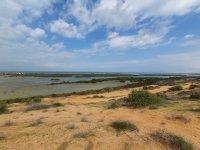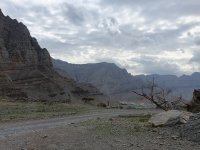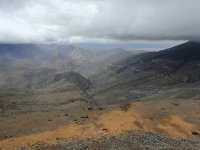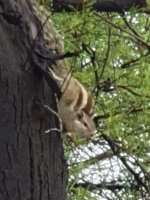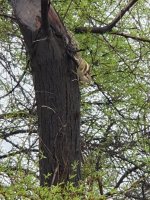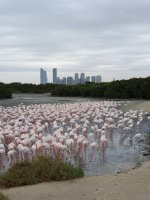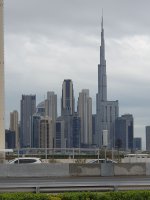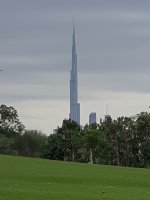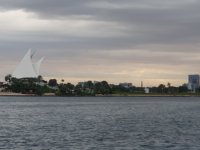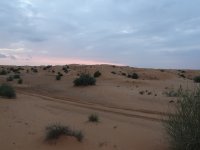Friday 27th January:
Today being my last day based in Dubai I decided to check out some of the local city parks before heading south, starting at Dubai Creek Park. My satnav took me to gate 4 where I parked and went to the booth and asked how much the entrance fee was. The answer was 5 dirham but you can no longer pay by cash or credit card but have to use a pre-loaded 'nol' card but this can only be obtained for 15 dirham (it also gets you into other attractions in the city) from gate 1! So I returned to the car, noting a small flock of Western Cattle Egret on the grass beyond the boundary fence, and set off for gate 1. Parking up again I asked the lady in the kiosk for the relevant card but her machine was not working properly, she just shrugged and told me to go in anyway through an open turnstile with a security guard who just let me through when I explained.
I set off anti-clockwise around the network of paths and soon realised that the park was packed with the common urban species: Collared & Laughing Doves, Ring-necked Parakeet, Roller, Hoopoe, Green Bee-eater, House Crow, White-eared & Red-vented Bulbul, Purple Sunbird and House Sparrow. There was also Red-wattled Lapwing on the lawns, Grey Francolin lurking in the shrubberies, a single Rufous Turtle Dove in a palm, a couple of Wood Pigeon feeding under some trees with the Feral Pigeons and some Pied Myna * mixed in amongst the numerous flocks of their Common cousins. Walking down the edge of Dubai Creek a Whimbrel and a Common Sandpiper were on the shoreline, Great Cormorants in flight and a Caspian Tern patrolled up and down. I enjoyed strolling around this birdy park and the views of the city skyline were impressive, especially the Burj Khalifa which is even taller than you expect.
Returning to the car I set off toward Ra's al Khor as drizzle was again threatening and I hoped to make use of the shelter of the hides. If approaching from the south beware that the satnav location for the Mangrove Hide given on the uaebirding site leads you to a spot on the opposite side of a 4 lane highway, two parallel 2-lane roads and a service road from the parking area and it then involves a tortuous re-route, road works and U-turns to get to where you can approach from the north. I eventually parked and was getting the scope sorted when the gate-man called me over and said the hide was closed - when I asked why he said it was always closed! I suspected a possible mistranslation but he told me the next hide around was open. So I carried on the short distance to the Flamingo Hide, which was indeed open. There were hundreds of Greater Flamingo and, through the bins, Spoonbill, Grey Heron, Great & Little Egret and Reef Heron were obvious and a closer check revealed a couple of Intermediate Egret where good size comparisons were possible. With the scope I also picked out some more distant Mallard, Black-winged Stilt, Curlew, Greenshank and a Grey Plover plus Black-headed and Slender-billed Gulls.
I next headed to Safa Park. The first parking area I found had payment machines that only accepted coins and I did not have enough to pay the fee and there were no shops in the area to get change. So I had a bit of a drive around and found what seemed to be a free parking area but it was the other side of a busy dual carriageway and I could not see any apparent way over. So I gave up and headed out of the city to Musharif National Park. Here I bought my 'nol' card to get in and parked in the main area setting off for a wander around what is a sort of adventure park/pic-nic area/woodland reserve beyond the suburbs. Although a family orientated location it was fairly quiet and large enough for me to be able to enjoy wandering around the native woodland areas in peace. The so far very common species were again common and for most of the time other birds were a bit sparse, although I did add White Wagtails trotting around the mown grass areas, had a couple of Barn Swallow over and an elusive bird in a more dense area eventually gave itself up as a Graceful Prinia *. By then the thunder and lightening of the previous day had returned and I had to shelter for a while under the roof overhang of a toilet block. Once the downpour was over, almost as suddenly as it had started, I continued my wandering back to the general area of the centre. Passing a block that seemed to be an orchard of larger trees, a large raptor lifted out of the top of one of the trees and disappeared into the canopy of another. I had seen a large raptor overhead before the rain storm but did not get any ID characteristics and it seemed as though this form was going to continue but I stopped for a good look around nevertheless. A wise move as I located another two large raptors in the tops of other trees in the orchard and one flew over to join the no longer visible first bird. These two remained hidden but the two visible ones and the close flight views I'd had allowed me to be sure that there were at least 4 Crested Honey Buzzard. The smaller birds in the trees seemed to generally ignore them but had a very different reaction when a Shikra shot through - a great few minutes.
With plenty of day-light still left and the clouds building again back toward the direction of the coast I set off inland to Qarn Nazwa. The interest here consists of three large outcrops in a sand desert area. Passing through the small adjacent town I tried to gain access to the eastern side of the outcrop but this area seems to have been completely taken over by adventure companies for 4-WD and dune buggy rides and was busy with noisy vehicles. So I returned to the town and turned south down a minor road to get close to the fenced-off western outcrop and the suggested stake-out for the main target species. I found a roadside pull-off and set up the scope in preparation. I must admit I was by this time not too hopeful as the road was busy with local traffic plus a lot of 4-WD's and buggies. There was also loud music coming from the other side of the 'mountain'. While it was still light I had a circling flock of Common Swift overhead and, scanning the slopes, watched two Arabian Sand Gazelle cross a sandy stretch and disappear behind a smaller rocky outcrop. The sun was now setting over the dunes so I turned my attention back to the summit of the outcrop. Luckily, as the sky darkened the vehicle activity lessened and the music stopped and shortly I heard the strange, booming 'booooor' call of my target. Putting all my concentration on scanning the serrated skyline I saw a superb Pharaoh Eagle Owl * fly up from the other side of the ridge and perch up on the top - unfortunately with its back to me but I could see the desert breeze ruffling it's feathers. I kept focused on it until it flew off out of sight just before it got too dark to see anything.
A great end to the day and time to head south to my second hotel in Abu Dhabi.
Photos: The order of the pictures in this post have changed so I have added the last few digits of the file number for clarity.
1. Dubai Creek Golf Club across the creek from Dubai Creek Park [092032];
2 & 3. Burj Khalifa from Dubai Creek Park & R'as al Khor respectively [092336 / 112501];
4. Contrasts - from Flamingo Hide at R'as al Khor [113624];
5 & 6. Five-striped Palm Squirrel - Musharif NP 150333 / 150335];
7. Sunset over the desert Qarn Nazwa [175354].








